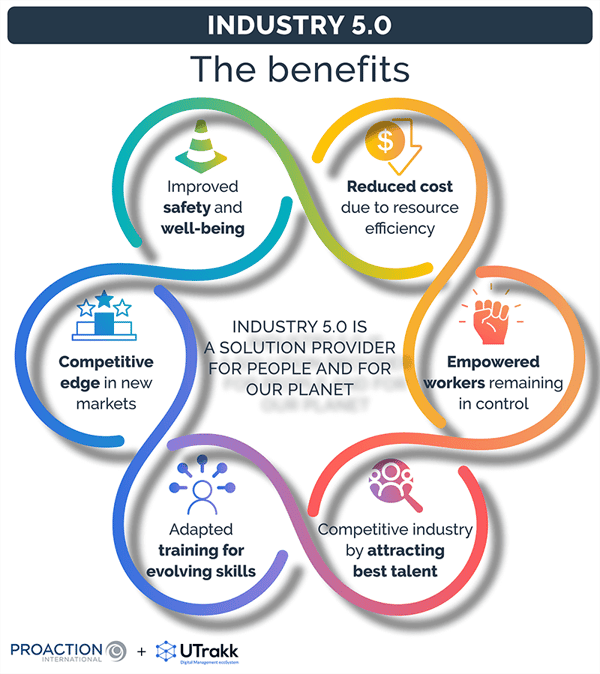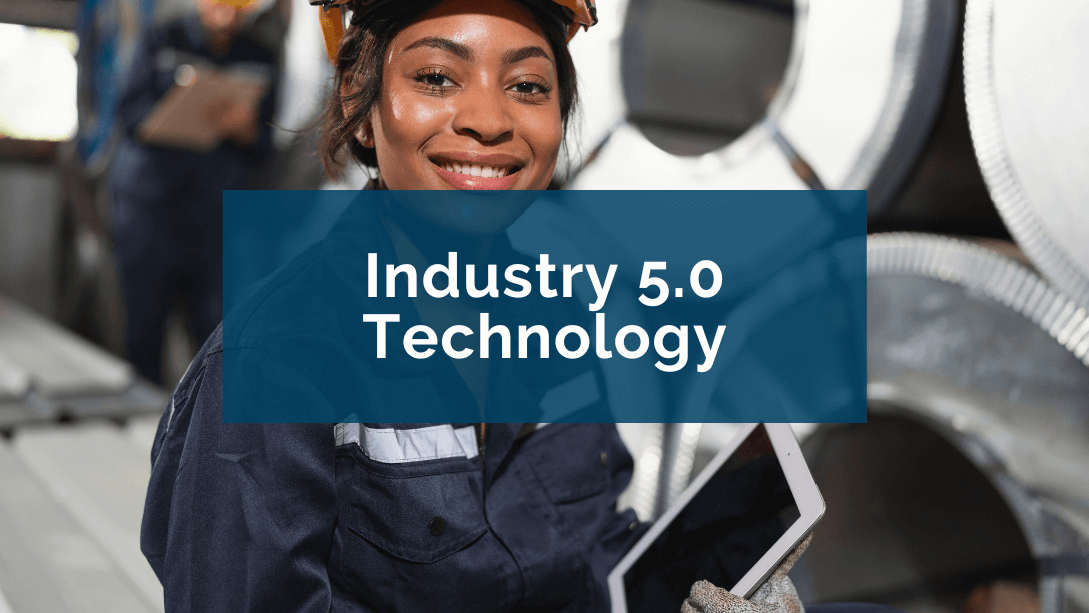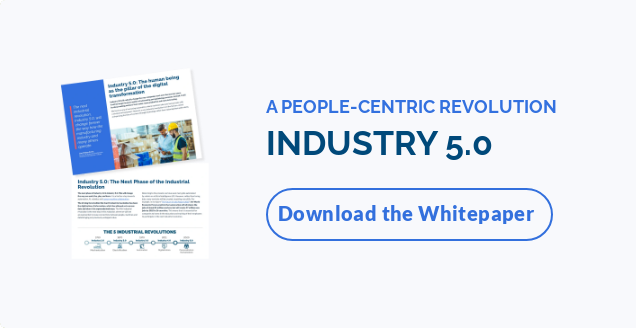The differences between the Fourth Industrial Revolution and the Fifth Industrial Revolution
Over the past decade, the fourth industrial revolution, or Industry 4.0, has represented a fundamental step forward, introducing innovative concepts (advanced industrial automation, big data analytics, cloud computing, cyber-physical systems, the Internet of Things, etc.). But it also raised concerns about man's place in this automated ecosystem. Faced with this, the Fifth Industrial Revolution presents itself not as an alternative paradigm but as a proactive response, refocusing attention on the added value of man within these smart systems.
But Industry 4.0 technologies are not being shelved for the 5.0 era! On the contrary, they continue to play a fundamental role, and the new industrial revolution complements these advances by adding a human touch to digital transformation, making workers critical players in industrial success.
The idea is to teach employees how to use 4.0 and 5.0 technologies to maximize efficiency and creativity within industrial sectors and enable companies to embrace this transition.
Industry 5.0 complements and develops the essential features of Industry 4.0. It focuses on the factors that will decisively determine the place of industry in the future European society; these factors are not only economic or technological but also have a fundamental environmental and social dimension.
What is Industry 5.0?
A people-centered approach is essential for a future that works for everyone.
Klaus Schwab, Chairman of the World Economic Forum

The 3 founding pillars
1. People-centricity: Putting people at the heart of the industry
Industry 5.0 is a human-centric industry. It takes a resolutely people-centric approach, recognizing that human interaction is irreplaceable in many aspects of the manufacturing process.
Unlike previous models, where advanced automation could crowd out the workforce, Industry 5.0 focuses on societal value and workers' skills, emotional intelligence, and creativity. Machines are no longer merely performers but collaborative partners that amplify rather than replace the capabilities of individuals.
2. Resilience: Flexibility and responsiveness
Flexibility at all levels is a significant pillar of Industry 5.0. Industrial systems are designed to be adaptable and respond quickly to change. Smart machines have advanced sensors and algorithms, enabling them to adjust to new situations without constant reprogramming.
The ability to adapt is particularly evident in customized production. Indeed, Industry 5.0 facilitates mass-customized manufacturing, responding to specific customer requests. Production lines can be quickly reconfigured to move from one production run to another, ensuring unprecedented agility in the manufacturing world.
3. Sustainability: Environmental and economic responsibility
Another fundamental concept of Industry 5.0 is sustainability. Industrial processes integrate planet-friendly practices, prioritizing renewable energies and minimizing waste, energy consumption, and emissions. This approach aligns economic interests with environmental responsibility, creating long-term sustainable business models.
Thanks to human-machine collaboration, Industry 5.0 promises greater operational efficiency and a more responsible and sustainable vision of the industry of the future.
Human and machine workers collaboration: The role of human contact in the production process
Embracing Industry 5.0 means understanding that the interaction between people and machines can create a more robust partnership than automation alone. Human contact greatly enhances the manufacturing process:
- It brings adaptability and flexibility to automated processes. Workers can quickly adjust parameters, solve unforeseen problems, and intervene in complex situations.
- It gives human operators a contextual understanding and decision-making capability based on complex, nuanced factors.
- It helps ensure product quality. Manufacturing workers can perform visual checks, detect minor defects, and guarantee high standards. It means fewer errors, fewer rejects, and lower associated costs.
- It encourages innovation, critical thinking, and creative problem-solving. Workers can develop innovative ideas, suggest improvements, and contribute to the constant evolution of production methods.
The technological foundations of the new industrial era
Industry 5.0 is based on a set of innovative enabling technologies that transcend the paradigms established by previous industrial eras.
Artificial intelligence (AI)
AI forms the backbone of Industry 5.0, allowing machines to learn, analyze, and make autonomous decisions. Complex AI algorithms enable machines to process and analyze vast volumes of data in real-time, paving the way for diverse applications and providing valuable insights.
Predictive analysis, another of AI's key strengths, is revolutionizing the planning of industrial operations. Using machine learning models, AI anticipates trends, identifies potential risks, and forecasts failures. This predictive capability enables proactive management of resources, accurate maintenance planning, and significantly reduced unplanned downtime.
At the same time, AI contributes to improving the overall efficiency of industrial production. Automating repetitive tasks and identifying inefficiencies in processes unleashes productivity potential.
Example: Vanti AI is a system designed for the manufacturing sector. Merging manufacturing data from multiple sources provides them with a specialized, automated, intuitive platform. Thanks to advanced natural language processing, Vanti AI can interpret complex production behaviors and provide reliable, actionable information.
Collaborative robots
Collaborative robotics involves using robots, or "cobots", working alongside human workers, sharing the workspace, and collaborating on specific tasks. It, therefore, pushes back the limits of simple automation, providing a winning combination of human skills and mechanical capabilities.
These robots incorporate sophisticated systems that enable them to perceive their environment with remarkable precision. This sensory capacity enables them to perform delicate, repetitive, and/or specialized tasks, freeing human workers from certain operational constraints.
Example: Universal Robots is a Danish manufacturer specializing in collaborative industrial robots. Some of their cobots help human operators with complex assembly tasks. They can precisely manipulate parts, position them, and help speed up assembly lines. They can adjust their force and movement according to workers' actions for safe and efficient collaboration.
Augmented reality and virtual reality
Augmented reality (AR) and virtual reality (VR) are significant tools for improving the man-machine interface, redefining how we interact with digital and physical environments.
Augmented reality enriches our perception of the natural world by superimposing digital information onto our physical environment. In the context of man-machine interface, this translates into practical applications, such as smart glasses or wearable devices, which display relevant data directly in the user's field of vision. These advanced technologies facilitate instant comprehension of complex data, visualization of instructions in real-time, and access to contextual information without diverting attention from the task.
On the other hand, virtual reality creates fully immersive environments, disconnecting users from physical reality and transporting them into virtual worlds. VR headsets enable users to manipulate virtual objects, perform realistic training simulations, and collaborate remotely with colleagues in shared virtual environments.
Example: AR can project step-by-step instructions directly onto parts during the assembly process, guiding workers through the assembly process intuitively.
Some operators use VR headsets to simulate emergency scenarios, maintenance procedures, and complex operations. It enables risk-free hands-on training and faster skills acquisition.
Additive manufacturing
Additive manufacturing, or 3D printing, enables the creation of objects layer by layer from various materials (plastic, metal, resin) following a three-dimensional digital model. This innovative approach offers unrivaled design flexibility, enabling the rapid creation of prototypes and critical components.
Additive manufacturing occupies a key position in Industry 5.0 for several reasons. Firstly, it paves the way for more agile production by enabling mass customization. 3D printing machines can produce one-off objects as quickly as standard production runs, meeting the growing demand for customized products.
What's more, it helps optimize production processes by reducing material wastage. Building objects layer by layer minimizes waste compared with traditional subtractive manufacturing systems.
Example: Custom-made tools and jigs can be created rapidly using 3D printing. It improves the efficiency of manufacturing operations and reduces production lead times.
Note that rapid advances in certain areas are also influencing Industry 5.0:
- 6G communication, as the next generation of wireless networks, promises even faster data transmission capabilities and connectivity.
- Advanced computing, like cloud manufacturing, for example, offers processing and analysis capabilities on an unprecedented scale for more innovative, faster decision-making. Machines become capable of learning and adapting, constantly optimizing production processes and improving operational efficiency.
- Implementing sustainable and smart manufacturing practices is gaining importance, moving the industry towards more responsible production. Companies are adopting more conscious approaches, optimizing resource use, reducing waste, and minimizing environmental impact.
Industry 5.0 is, therefore, not just a technological evolution but a global transformation redefining how organizations design, produce, and interact with their environment, creating a brighter, more efficient, and more sustainable industrial future.
How Proaction International helps companies succeed in Industry 5.0
To increase productivity, investing in equipment, improving work processes, and enhancing management skills is important. In recent years, most companies have invested more in equipment than in people (their managers, supervisors, and directors). Improving managers' management skills is the key to increasing productivity and creating wealth.
Denis Lefebvre, CEO of Proaction International
At Proaction International, we firmly believe that people are a crucial factor in operational performance because, behind every machine, every process, and every product/service lies one or several skilled workers. Industry 5.0, or at least its fundamentals, was already part of our values even before its advent.
To make it easier for you, as companies, to adopt Industrie 5.0 and prepare for the future, here are 3 points we consider essential:
Leadership development through coaching
Industry 5.0 is characterized by rapid change and constant technological evolution. Leadership must, therefore, be adaptable and agile.
Coaching enables leaders, executives, and frontline managers to develop interpersonal skills and acquire the right management reflexes and flexibility to navigate changing environments.
Industry 5.0 also requires leaders to inspire and mobilize employees around a shared vision. Coaching contributes to adopting transformational leadership, enabling leaders and managers to generate enthusiasm, cultivate creativity and innovation, and encourage team initiative.
Besides the behavioral aspect, coaching is also an excellent way for leaders to improve their digital and technological skills to navigate effectively in the industrial 5.0 environment. It includes understanding emerging technologies, data-driven decision-making, and the ability to guide teams in the successful adoption of these new supporting technologies.
Key behavioral indicators
Used alongside leadership development, key behavioral indicators (KBIs) will enable us to measure leaders' ability to integrate and apply the knowledge and skills acquired during coaching.
They are invaluable tools for assessing, guiding, and optimizing the process of adopting Industry 5.0 within an organization. These indicators facilitate the transition to a more connected, intelligent industrial environment focused on man-machine collaboration by focusing on human aspects.
Digitizing leadership development in UTrakk
UTrakk is a Daily Management System (DMS) that supports the development of leadership skills in operations management.
How does it work? This comprehensive, user-friendly platform provides step-by-step support for managers in their roles and daily activities, giving them an overview of priorities, actions, and key performance indicators (including behavioral indicators).
To this end, UTrakk includes numerous operations management functions, such as task and priority planning, active supervision rounds, team rituals (meetings), and dashboards. However, this system is an ally of Industry 5.0 because its functionalities integrate the human aspect by promoting good managerial behavior in operations management.
For example, digitalized Gemba Walks include questions that enable the manager to rigorously and efficiently monitor daily production and identify and resolve any discrepancies quickly.
In addition, the manager has access to a personalized coaching plan via UTrakk's "Coaching" module. This coaching plan includes a questionnaire that enables the coach to assess the development and progression of the leader's skills.
The activities described in these examples are measured using key behavioral indicators. These are tracked using dashboards in the daily management system, enabling progress to be visualized at a glance and areas for improvement to be identified.
UTrakk boosts not only operational performance but also that of managers to maximize their impact on the organization, whether in terms of production efficiency, team engagement, or process optimization. UTrakk's digitized approach to leadership development fosters a more fulfilling work environment for employees, making it a genuine DMS 5.0.
Industry 5.0: Paving the way for perfect synergy between people and advanced technology
The Industry of the Future approach benefits industry, workers, and society. It empowers workers and responds to changing employee skills and training needs. It makes the industry more competitive and helps attract the best talent. It's good for our planet because it promotes circular production models and supports technologies that make the use of natural resources more efficient.

In Industry 5.0, workers interact closely with intelligent machines, sharing tasks and responsibilities. Bringing these two worlds together, taking the best from each other rather than pitting them against each other, enables unprecedented efficiency, personalization, and sustainability. However, the success of this transition will depend on our ability to meet the ethical and ecological challenges and to prepare the workforce to meet the technological demands of the future.
By fostering close collaboration between people and machines, encouraging innovation, and integrating cutting-edge technologies, Industry 5.0 paves the way for a future where production becomes more efficient, human, sustainable, and adaptive. It's a transformation that promises to fundamentally reshape how we design, produce, and interact with the world around us.









